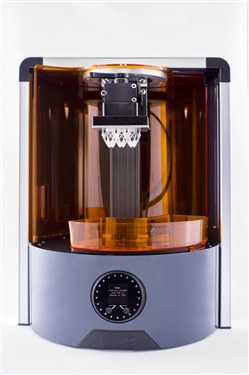SSZTCJ9 june 2015 DLP4500 , DLP4500NIR
Autodesk brings its Ember 3D printer to market with help from TI DLP® technology-- you can see it below

When we take Ember to a show or event, it seems to attract its fair share of attention and raise questions that we love to answer.
From, “Wait, Autodesk is making hardware?” to “What is the resolution,” or "What is it doing?” and “Why did you start here?”
We love questions and love to meet new people, but we thought we would take this opportunity to provide a bit of additional background on the development of the Ember 3D printer.
We should start with, yes, Autodesk made a 3D printer. We believe 3D printing is essential to the future of making things. We want to see this technology advance much more rapidly so we launched the Spark 3D printing platform and with it, the Ember 3D printer. But what most people don’t know is the Ember origin story. Here it is as told by Arian Aghababaie and Pierre Lin, principal engineers of the Ember team.
Pierre and I studied aerospace engineering in the United Kingdom. Despite our education, we were frustrated by the lack of hands on engineering experience and we rarely had a chance to make anything! After graduating, the open source 3D printing community had started to gain traction and it was becoming evident that with the advent of low cost systems, the technology would empower designers and engineers.
Whilst the promise of the technology was tantalizing, the realization and execution had been, in reality, disappointing. We decided to start a company together with the vision of removing the barriers of adoption typically associated with 3D printing by developing high-resolution systems with a seamless user experience that could be used in a meaningful way.
After progressing through an investigation of each of the technologies, we settled on DLP technology for two key reasons; high-resolution and speed. With native HD resolution such as 720p, finding available technology that would enable us to print at such high resolution and at certain speeds proved difficult.
We also happened to be at the right place at the right time; Texas Instruments had just released the low cost 0.45-inch digital micromirror device (DMD) and LED manufacturers were producing low cost, high power 405nm LEDs - crucial to the photo-polymersiation process of commercially available resins. Working with a DLP design house, we were able to design and build the high quality projection unit we needed from the ground up.
With a prototype in hand, we joined forces with Autodesk in order to execute on our vision of a seamless user experience. With Autodesk’s long history in design software and their commitment to 3D printing, we were able to develop and refine the hardware, whilst concurrently developing the software and materials. This ultimately resulted in Ember.
We are really proud of the high resolution, superb surface finishes, high throughput and reliability of this printer. SLA technology enabled with DLP chipsets makes Ember an incredible tool for multiple business applications. As part of Autodesk’s open approach to 3D printing, we released the source CAD design files for the Ember printer, and what we are most excited about is seeing what the brilliant minds in the 3D printing industry will do with it.